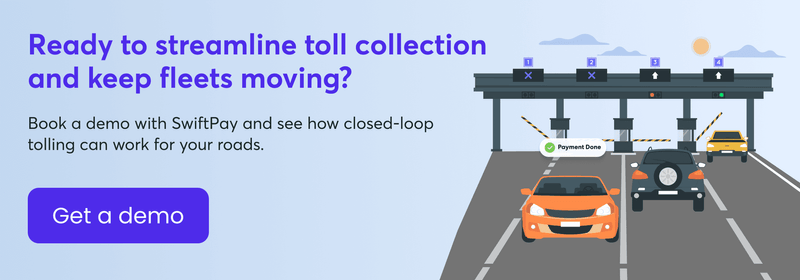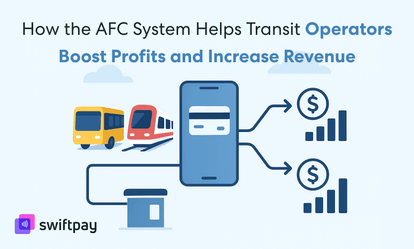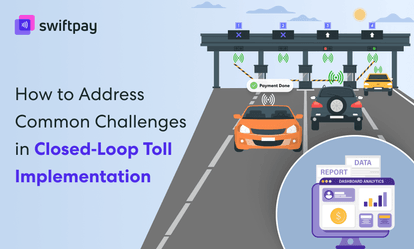If you’re in charge of toll operations, chances are your biggest concern is revenue collection. But there’s another equally important aspect that often goes unnoticed: traffic flow.
Specifically, how your toll collection system affects vehicle movement, especially for fleets.
It may not seem like a big deal when a truck waits an extra 30 seconds at a toll booth. But when that happens hundreds of times a day, across dozens of checkpoints, the delays pile up.
And those delays don’t just frustrate drivers; they disrupt logistics, increase fuel usage, and throw fleet schedules off track.
So the real question is: Can toll collection improve fleet efficiency rather than slow it down?
Yes, but only if it’s done right. And that’s what this blog is all about.
Here’s what you will know:
- Why toll collection systems play a bigger role in road efficiency than most realize
- What’s broken in today’s toll payment system
- And how closed-loop toll collection systems can help fix it
Let’s begin by understanding the connection between toll collection and fleet efficiency.
Tolling isn’t just about collection; how fast and efficiently it is collected affects the movement of vehicles.
Most people see tolls as payment checkpoints—where vehicles stop, pay, and move on. But for toll operators and fleet managers, those few seconds at each booth can determine how efficiently the entire network runs.
The toll booth as a bottleneck
Even the most well-designed road systems can’t escape one simple truth: when tolls aren’t seamless, traffic slows down.
And when fleets are involved—with time-sensitive delivery targets and operational costs on the line—every second counts.
A fleet that’s forced to slow down or stop frequently burns more fuel, takes longer to complete trips, and needs more frequent maintenance. Multiply that across thousands of trips, and the cost of inefficiency becomes crystal clear.
What’s Holding Back Efficiency in Current Toll Collection Systems?
Most toll inefficiencies don’t come from bad roads or poor planning. They come from outdated or inconsistent payment systems. Let’s look at a few common culprits.
Manual booths still exist
Despite increasing automation, manual cash collection or printed tickets are still the norm in many regions. These systems are slow, error-prone, and a major source of congestion during peak hours.
Patchy automation across networks
Some toll points support RFID tags, while others expect physical cards. There’s little consistency, which confuses drivers and slows down processing.
Over-reliance on open-loop payments
Toll setups that rely on bank cards or mobile wallets often face transaction failures, API delays, or poor network issues, especially in remote areas. If the bank server doesn’t respond, the vehicle doesn’t move.
Unnecessary vehicle stops
Each halt — whether due to system lags, mismatched formats, or low balances — adds to fleet fatigue. And unlike private cars, fleets can’t afford unpredictability.
The Real Cost of Inefficient Toll Collection for Fleet Operators
It’s easy to think of the aforementioned issues as minor, but for logistics companies and fleet operators, they’re a real burden.
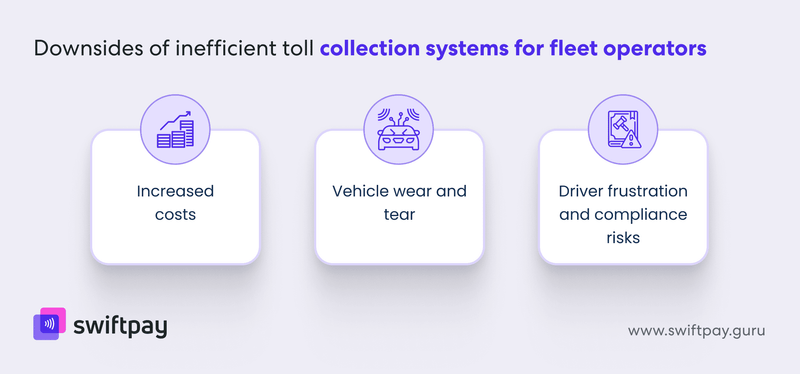
Increased costs
Delays at toll booths ripple down into delivery schedules, staffing, and service-level agreements (SLAs). If a fleet driver takes longer to complete a trip, it increases the cost per kilometer.
Vehicle wear and tear
Every time a truck stops and starts again, it adds stress to the brakes, engine, and tires. This leads to higher maintenance costs and shorter vehicle lifespans.
Driver frustration and compliance risks
Extended hours on the road — due to tolling delays — can push drivers beyond their permitted limits. This not only affects morale but also creates compliance risks for fleet companies.
Read more: Top 5 Toll Collection Challenges (And How To Fix Them)
What Efficient Toll Collection Systems Should Actually Look Like
If the goal is smooth traffic and satisfied drivers, then toll systems must be built for speed, consistency, and independence.
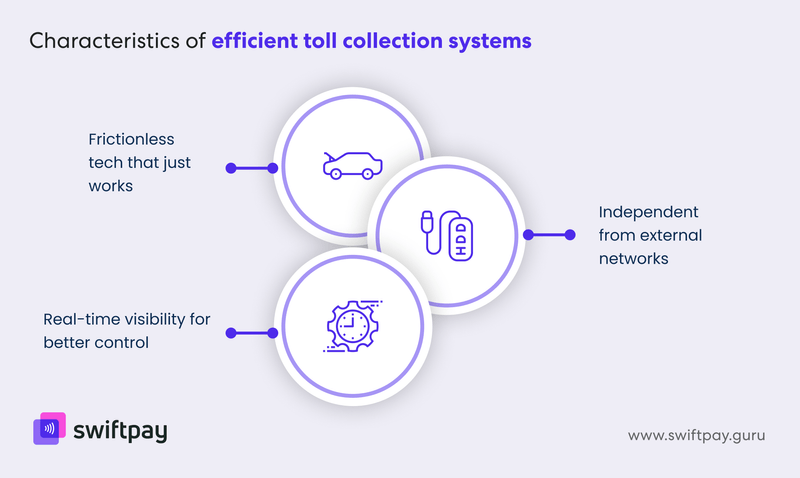
Frictionless tech that just works
Modern toll collection systems use RFID tags, vehicle number plate scanning, or contactless smart cards to process tolls without requiring the vehicle to stop. The entire interaction happens in seconds, not minutes.
This minimizes human contact, reduces entry and exit delays, and keeps traffic flowing even during busy hours.
Independent from external networks
A common problem with open-loop tolling is its reliance on third-party banks or payment gateways. When they fail or lag, so does your booth. An ideal toll setup should work even in low-connectivity zones, with transactions processed inside a closed, self-contained system.
Real-time visibility for better control
Toll operators like you need instant transaction data, vehicle tracking, and usage insights. That’s crucial because that helps with dispute resolution, route analysis, and overall traffic management. It also gives you the data you need to plan better.
How Automated Toll Collection Systems Makes a Difference on the Ground
Here’s how automatic toll collection makes a real impact where it matters:
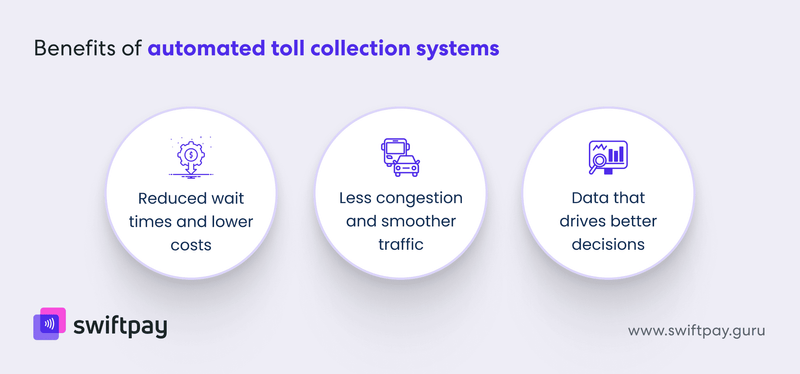
Reduced wait times, lower costs
Automatic toll collection allows vehicles to clear tolls faster. It also reduces idle time and fuel waste. Over time, this leads to tangible cost savings for logistics companies.
Less congestion, smoother traffic
When vehicles don’t need to stop or queue, overall road congestion drops, especially at peak hours. This improves both driver satisfaction and public perception of the tolling experience.
Data that drives better decisions
Operators like you get access to detailed movement logs, payment reports, and fleet trends. This helps with predictive planning, route optimization, and peak-time preparedness.
Introducing SwiftPay: Built for Fast and Efficient Closed-Loop Toll Collection System
By now, it’s clear that today’s non-uniform toll systems are no longer fit for high-efficiency roads. And if you want to make toll collection more streamlined and increase fleet efficiency, then SwiftPay can help.
SwiftPay is a closed-loop toll collection solution built to make tolling faster, smarter, and more reliable—both for toll operators like you and the fleets that use your roads.
Here’s how it’s different:
Designed for speed
SwiftPay uses secure RFID tags that process payments in real time, without the need for bank cards, OTPs, or app approvals. That means vehicles keep moving, even during network drops.
Full control, no third parties
Since it’s a closed-loop system, you don’t depend on third-party payment providers or banks. You set the rules, define exemptions, and manage fees without worrying about transaction failures from the outside.
Built-in flexibility
SwiftPay supports multiple use cases. From single-lane highways to multi-lane expressways, it is suitable for all types of roads.
It can also be customized with fleet-based discounts, subscription toll passes, or tiered pricing structures.
Final Thoughts: Efficiency Starts at the Toll Booth
Fleet optimization doesn’t always require better roads or new infrastructure. Sometimes, the biggest improvements come from fixing the friction points, and toll collection is a major one.
If your toll collection system is still relying on outdated, disconnected mechanisms, it’s time to rethink the foundation.
You should consider implementing automated and closed-loop toll collection systems. That’s where SwiftPay offers you a future-ready alternative—one that’s fast, reliable, and purpose-built for modern toll operations.
It’s not just about collecting tolls. It’s also about doing it in a way that keeps vehicles moving without any disruption.
